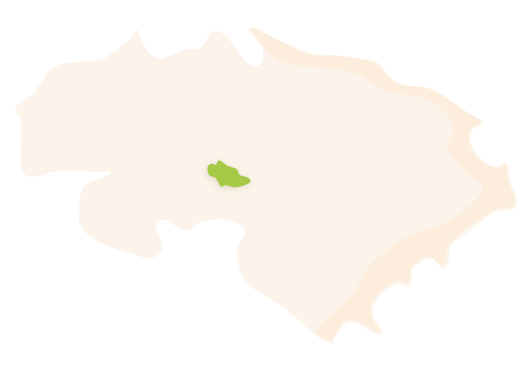Murla is an inland municipality of La Marina Alta, located in the middle of La Vall de Pop on the upper course of the River Gorgos. Framed by the mountain known as El Cavall Verd and the river basin, it sits at an altitude of 285 metres and covers an area of 5.8 km². It is home to 549 inhabitants called Murlers and Murleres.
 Murla's municipal district. Surface area: 5.8 km². Population: 549 (INE data 2021).
Murla's municipal district. Surface area: 5.8 km². Population: 549 (INE data 2021).HISTORY
The origins of Murla can be traced back to a mediaeval farmstead that expanded next to the castle of Pop, which the author Severino Giner notes was Murla’s fortified church. Historically, La Vall de Pop only consisted of Benigembla, Parcent and Murla, all of which were under the administrative control of the hîsn or castle of Pop.
Although remains and materials from the Iberian and Roman eras have been found in the area, the current settlement is the result of the Muslim period. In the 11th century, Murla dominated the access to the valley. Due to the serfdom pact that Al-Azraq signed with the infant Alfons, the first-born son of Jaume I, the Muslim leader ceded the income from Murla to the king. In 1296, Jaume II made a lifetime donation to his advisor Ramon de Vilanova, making it a domain of the Vilanova family for a long time.
The village of Murla is considered, along with Benissa and Ondara, a mixed Christian settlement. These places were characterised by having suburbs or quarters for the Muslim population, separated from the Christian population. It is probably for this reason that, in 1341, the Almedic settlement charter was granted to 17 Saracens from Murla by Maria Ladrón de Vidaure, in order for them to build a new village intended exclusively for Muslims, but it seems that this never came into effect.
Another occasion that stands out in the history of Murla is an attack suffered at the hands of Red Beard’s pirates. In October 1529, the lieutenant of the famous Mediterranean pirate, the so-called “Cachidiablo”, attacked and plundered Murla and Parcent.
This history halfway between Muslims and Christians has been reflected in Murla’s coat of arms. Approved on the 30th of January 1989, it shows a shield divided into three parts. On the left, in memory of the old mediaeval fortress, one sees a red castle with a gold background. In the top right with a silver background, the cross of Saint Jaume in red, symbolising Christianity. Finally, in the bottom right, one sees the silver crescent, or the Arabic crescent moon.
If there is one important historical event in which Murla was the protagonist, it was the Laguar revolt, in which the village became a battlefield. The chapel of Saint Sebastià on the way up to Cavall Verd was sacked and burnt by the Moors who were climbing up to make a stronghold on the mountain called El Penyó. In the meantime, Murla became a camp for the king's regiments, with Sancho de Luna Marqués as the leading officer. After the expulsion of the Moors, it seems that Murla was repopulated by native Christians and Majorcans, as demonstrated by the surnames Mas, Femenia, Cloquell and Riera.
Murla is a village with an agricultural tradition of dryland crops such as almond trees and vines. Due to the phylloxera crisis there was a great deal of migration, primarily to the United States, which to this day has not been reversed. Another of Murla’s claims to fame is that of being the cradle of the Valencian pilota, a traditional handball game, with notable characters such as Nel de Murla.
FESTIVITIES
- The festa of Saint Sebastià is celebrated on the Saturday closest to January 20th.
- Saint Miquel is celebrated on the Saturday following the liturgical feast dedicated to him, which takes place on September 29th.
- The Divine Aurora and the Moors and Christians festivities are celebrated on August 5th.
GASTRONOMY
- “Borreta de melva”. “Borra” is one of the region’s most characteristic and oldest dishes and is a way of preserving the products of the family allotment which, in times of abundance, were dried in the sun on reeds. Essentially, it is a stew of vegetables and salted fish, especially cod and halibut, although there are also those who make it with tuna or cuttlefish. The Murla variation is known as “borreta de melva”.
- “Putxero tradicional amb pilotes” (meatball stew).
- “Pa perdut”. Made from slices of old bread soaked in milk, then sprinkled with sugar and cinnamon and served hot.
- “Grinyons”. A whole wheat and vegetable stew also known as “blat picat”, “olleta de blat” or “guisat de blat”. It is undoubtedly one of the oldest dishes in Mediterranean cuisine since wheat (blat), grapes and olives make up the basic elements of the regional diet: the “Mediterranean trilogy”.
INTEREST SITES
- LIC Conca del riu Gorgos.